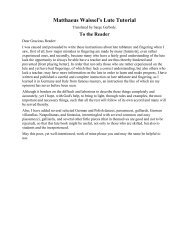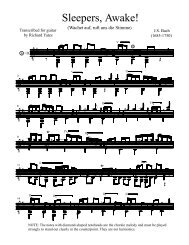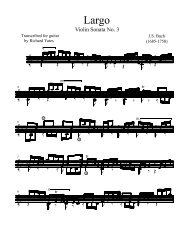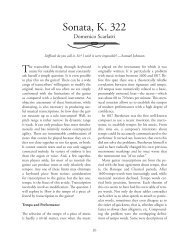The Transcriber's Art - Richard Yates Classical Guitar Transcriptions
The Transcriber's Art - Richard Yates Classical Guitar Transcriptions
The Transcriber's Art - Richard Yates Classical Guitar Transcriptions
Create successful ePaper yourself
Turn your PDF publications into a flip-book with our unique Google optimized e-Paper software.
Almaine, John Jenkins, XI-24 (edfhf), e 1 c 1 aeAE, Harpe Sette Flat<br />
<strong>The</strong> tuning was used primarily for minor key pieces. A related tuning used the equivalent<br />
of a C sharp for the second string and was called, unsurprisingly, “Harpe Sette sharp”.<br />
In measure five the asterisks mark two notes that were probably errors in the<br />
tablature, where they were written for the open fifth and fourth string instead of for the<br />
sixth and fifth. This is one of the most common errors in tablature manuscripts—the right<br />
symbol on the wrong string.<br />
Untitled, Stephen Goodall, I-16 (ffeff) e 1 bf#dAE, Violl Waye<br />
<strong>The</strong>re are six pieces by Stephen Goodall in <strong>The</strong> Manchester Gamba Book but, aside from<br />
this small sample, nothing else is known about his life or music. <strong>The</strong> untitled piece<br />
included here is the only one in Renaissance lute tuning. Because of the similarity to<br />
guitar tuning, transcription is usually straightforward (but this does not imply that it<br />
always works well!). <strong>The</strong> interesting feature of this piece is that it avoided the first string<br />
of the lyra-viol entirely. <strong>The</strong> tuning of the remaining five strings is feff which is identical<br />
to the first five strings of the guitar! This meant that transcription required no changes to<br />
the original at all, just that it be transposed a perfect fourth higher. <strong>The</strong> result is a<br />
remarkably delicate set of divisions that I find reminiscent of the clavichord and that<br />
would be marred by a pedestrian addition of lower bass notes to “fill it out.”<br />
Note the use of two different types of hemiola. <strong>The</strong> first one closes the opening and<br />
second statements where the 3/4 meter becomes 6/8 in measure 7. <strong>The</strong>n in the third and<br />
fourth statements, a larger-scale hemiola occurs where two measures of 3/4 become the<br />
equivalent of one measure of 3/2.<br />
Paven, Joseph Sherlie, III-11 (fefhf), e 1 bgdGD, Lyra Waye<br />
Sherlie (fl. London, 1607–10) has a surviving output comprising just 20 lyra-viol pieces<br />
that are similar in style to the dances of Alfonso Ferrabosco. <strong>The</strong> Paven is a dance in<br />
duple meter usually with a sedate character and a regular metrical structure. It was a<br />
common form for English composers until about 1625.<br />
Another characteristic of some lyra-viol music is a specialized set of ornaments or<br />
“graces,” although in the pieces presented here the only one is the grace note in measure<br />
three. <strong>The</strong> term for this one was a “backfall.” <strong>The</strong> trill in measure 10 was written out in<br />
this manuscript but could as easily have been written with a sign for a “shaked backfall<br />
and relish.”<br />
Untitled, John Jenkins, XIII-4 (fdefh), e 1 bg#eBE, High Harp Way sharp<br />
This piece was also written for an open tuning, and was easily dissected into a throughcomposed<br />
two-voice texture. This means that the leaps in the top line are melodic, not<br />
contrapuntal, and the fingering can be arranged to facilitate their execution. Specifically,<br />
it is helpful to play them on a single string to prevent the ringing over of the first note that<br />
might otherwise cloud the line. And so in several spots the note E is assigned to the<br />
second string rather than the open first string. In performance, playing the first notes of<br />
these leaps a bit staccato can clarify the gesture. <strong>The</strong> trills are editorial, but characteristic.


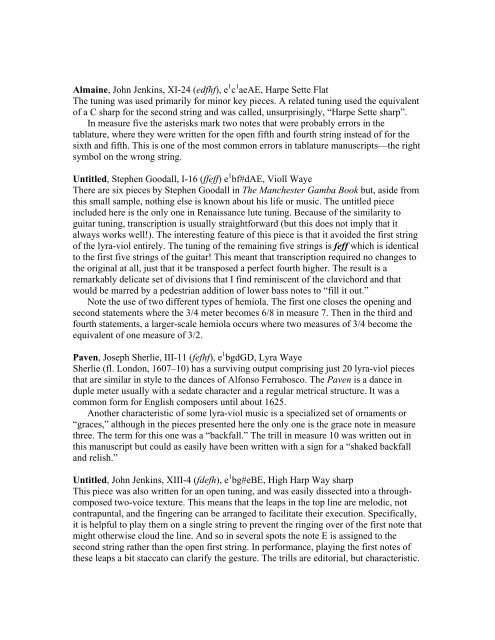


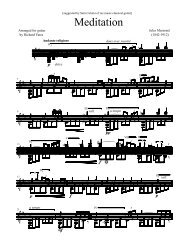
![Finale 2005b - [BWV846-Prelude in C.MUS]](https://img.yumpu.com/43978887/1/190x245/finale-2005b-bwv846-prelude-in-cmus.jpg?quality=85)
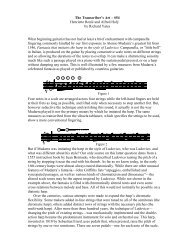
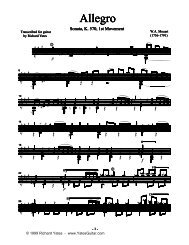

![Finale 2005b - [AirG-TAB.MUS] - Richard Yates Classical Guitar ...](https://img.yumpu.com/37104901/1/190x245/finale-2005b-airg-tabmus-richard-yates-classical-guitar-.jpg?quality=85)

